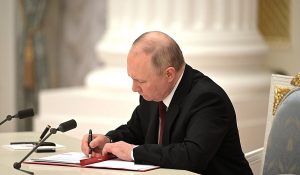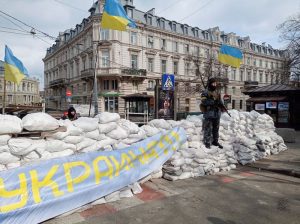On Friday, the Deputy Commander of Russia’s Central Military District announced that the primary objective of what appears to be a new “Phase Two” of the invasion is to secure control of Ukraine’s south while also pushing to take over the rest of Donbas. While speaking at the annual Union of Defense Industry Enterprises, General Rustam Minnekayev stated “one of the tasks of the Russian army is to establish full control over Donbas and southern Ukraine. This will provide a land corridor to Crimea, as well as affecting vital objects of the Ukrainian economy, Black Sea ports through which agricultural and metallurgical products are supplied to [other] countries,” according to Russian media. He also added that “control over the south of Ukraine is another exit into Transnistria, where there are also facts pointing to the oppression of the Russian-speaking population,” per Russian state-owned media outlet TASS.
The latest announcement appears to be yet another reposturing of Russian military objects in Ukraine and reframing of the conflict. Below, I will provide a brief timeline and evolution of goals and objectives Russia announced before and during the invasion:
- February 21: Russian President Vladimir Putin officially recognizes the independence of the separatist Donetsk People’s Republic and Luhansk People’s Republic. Before doing so, he addressed Russia, accusing Ukraine of committing geoncide against Russian speaking people in Donbass, lashing out at NATO expansion, and stating that Russian intervention would be necessary to counter Ukraine. Immediately after recognizing the DPR and LPR, “peacekeeping operations” were ordered in Donbas.

- February 22: Kremlin spokesman Dmitry Peskov has announced that Russia recognizes the independence of DPR and LPR area “in the borders that existed when they proclaimed” their own independence in 2014, meaning that Russia considers the entirety of Donbas rightful parts of the separatist states.
- February 22: Russia’s Parliament voted in favor of allowing President Vladimir Putin to use military forces abroad as needed. This is in regards to formally allowing Russian troops to enter Donbas for what Russia says is “peacekeeping operations,” although there is already evidence of their presence in the region.
- February 23: Leaders of the DPR and LPR have requested military assistance from Russian President Putin to “repel military aggression of the Ukrainian regime” and “prevent civilian casualties and a humanitarian catastrophe.”
- February 24: While addressing Russia in an emergency statement, President Vladimir Putin stated that “Russia cannot feel secure with [the threat from] Ukraine,” adding “I have declared a special military operation aimed at demilitarization and denazification of Ukraine.” Missile and rocket attacks against Ukrainian military targets commenced immediately afterwards as Russian ground forces began to push in from Crimea, Russia, and Belarus.
Russian President Vladimir Putin said he had authorized a special military operation in breakaway areas of eastern Ukraine https://t.co/bgrx6EmZWl pic.twitter.com/WhXasuR9gs
— Reuters (@Reuters) February 24, 2022
- March 25: Russia’s Military announces that the invasion has entered its “second phase” in which It has achieved its strategic goals in Ukraine, no longer deeming it necessary to take major population centers, but rather focus on the independence of separatist areas. According to Russia, the first phase of operations in the Ukraine were to suppress their combat abilities, stating “The combat potential of the Armed Forces of Ukraine has been considerably reduced, which … makes it possible to focus our core efforts on achieving the main goal, the liberation of Donbas.”
- At this point in the conflict, Russian attempts to capture Kyiv were stalled for weeks. An attempt to secure the Hostomel airport in the initial days of the invasion to secure a sky bridge ultimately failed as damage to runways made it impossible to land transport aircraft. Meanwhile, attempts to push in from Irpin and Bucha to the northwest and Brovary to the northeast were countered. A month into the conflict, Russian ground forces were unable to break through to the capital. Due to this, the West viewed the apparent shift in tactical goals to be a strategic reframing of the invasion to compensate for tactical failures to the north. A renewed focus on Donbas could yield more tactical victories. At this point as well, there was an apparent abandonment of their goals to “demilitarize” and “denazify” the country and rather a sole effort to secure Ukraine’s east.
- March 29: Amid peace talks in Turkey between Ukraine and Russia, Russian Deputy Defense Minister Alexander Fomin stated “Due to the fact that negotiations on the preparation of an agreement on the neutrality and non-nuclear status of Ukraine, as well as on the provision of security guarantees to Ukraine, are moving into practice, taking into account the principles discussed during today’s meeting, by the Ministry of Defense of the Russian Federation in order to increase mutual trust and create the necessary conditions for further negotiations and achieving the ultimate goal of agreeing on the signing of the above agreement, a decision was made to radically, at times, reduce military activity in the Kiev and Chernigov direction.” Over the next several weeks, Russian forces withdrew from areas around Kyiv, Chernihiv, and Sumy. These forces, however, began to regroup, rearm, and redeploy to Donbas to bolster ongoing operations as per “second phase” directives.
- April 18: Ukraine President Zelensky has reports Russia’s offensive to take the Donbas region has begun. It is believed that Russia will try to take over the region by May 9 to show it off as a wartime achievement for Victory Day, so the timeline is three weeks.
There are several aspects to this military plan and I am going to break down each one.
Donbas
Donbas has been a primary objective of Russia since the start of the invasion. Since the region had seen ongoing fighting between Ukrainian and separatist forces since the outbreak of the Ukraine civil war, the frontlines were dug in and heavily defended. Due to this, neither side had been able to make significant advances. To make up for this, separatist forces pushed north while Russian forces pushed east from Kharkiv. Heavy fighting is now centralized at Izyum, Horkliva, and Velyka Novosilka as Russian forces attempt a pincer move on Ukrainian forces in the region.
Here is today's control-of-terrain map for #Russia's invasion of #Ukraine from @TheStudyofWar and @criticalthreats. Axis-specific maps to follow. pic.twitter.com/PpKfNQfINM
— ISW (@TheStudyofWar) April 22, 2022
Fully capturing Donbas has several benefits for the Russians. The first is that it can be used as leverage during peace negotiations, potentially pushing for concessions over the region to halt fighting. With already loyal fighting forces from the DPR and LPR, it would be relatively easy to hold onto control and enforce order in the region, as well as secure its vital mining and industrial infrastructure. Donbas also plays into Russian identity, as parts of the populace are Russian speaking and/or identify as Russian, which can be used a a massive victory in safeguarding ethnic Russians.
Mariupol and a Land Bridge to Crimea
The siege of Mariupol has been ongoing for weeks as remaining Ukrainian resistance has been surrounded at the Azovstal industrial complex. The complete fall of the city would be a major and symbolic victory for the Russians, who can say they wiped out the Azov battalion and now control one of Ukraine’s most vital ports. While nearly all of the city and surrounding area is under Russian control, a total victory would mark the start of Russia’s much desired land bridge to Crimea and completely cut off Ukranian access to the Azov sea. Such a landbridge has been talked about in Russian policy and strategy for years now, as it would allow for strategic and economic dominance over the area while simultaneously striking blows to Ukraine’s own economy. Mariupol’s port can be used to open up maritime exports for Donbas steel and mining industries and expand road and railways from Donbas to Crimea. Holding on to such a land bridge may be a formidable task as it cuts into areas not sympathetic to Russia and will likely face resistance and sabotage operations.
Kherson and Zaporizhzhia
Ukraine believes that Russia is preparing to hold rigged independence referendums in Kherson and Zaporizhzhia in an attempt to legitimize their control over the cities, suggesting possible plans for long-term occupation. Kherson was the first major city to fall to Russian forces during the invasion, but has faced frequent protests and opposition by locals.
Odessa

Odessa is Ukraine’s largest seaport and a major economic hub for the Black Sea. Since the start of the invasion, there has been speculation of a large-scale amphibious assault to take the city, prompting locals and military forces to bolster positions along the shore. However, there has yet to be any attempts to take the city. Aside from naval forces, Russian ground forces have been held up at Mikylaiv by Ukrainian counter offensives, halting any offensives pushing west towards the city. The capture of Odessa by Russia and the remaining shorelines to the Black Sea would effectively landlock Ukraine and cut off any maritime export potential. Tangentially, it would greatly expand economic opportunities for Russia and help dominate sea trade.
Transnistria

Transnistria is an unrecognized, pro-Russian breakaway state of Moldova that already has a contingent of 1,000 Russian troops there. Russian military operations in Transnistria have been feared by Moldova since the outbreak of the invasion. For Russia, such an operation can be framed as saving ethnix Russians similarly to Donbas, as previously seen with the quote “there are also facts pointing to the oppression of the Russian-speaking population.” It’s unclear if Russia has plans to annex the region.


